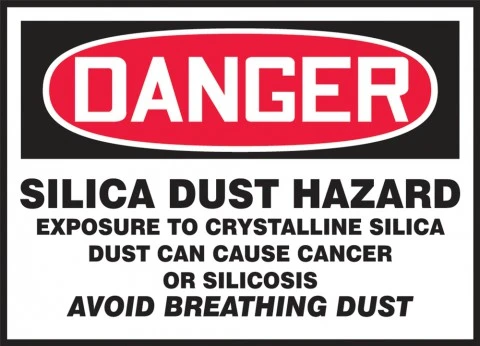
Extended inhalation of crystalline silica dust in the workplace is a silent killer because it can cause silicosis. In the United States alone, an average of 250 workers die each year with silicosis. (Source: NIOSH) In addition to silicosis, scientists have discovered connections between silica dust exposure and conditions such as bronchitis, tuberculosis, COPD, kidney disease, and lung cancer.
What is silica dust?
Silica is a common mineral found in the earth’s crust. Silica on the worksite comes from soil, sand, concrete, masonry, rock, granite, and landscaping materials. It becomes dust when you cut, grind, drill, or disturb any of these materials. Exposure to this harmful substance is most common in the following industries:
- Construction
- Mining
- Foundry work
- Ceramics, clay, pottery
- Stone cutting
- Glass manufacturing
- Agriculture
- Shipyards
- Railroad
- Manufacturing and use of abrasives
- Manufacturing of soaps and detergents
Am I at risk for exposure?
You may be at risk of getting silicosis if you work in a dusty environment where silica dust is present, but it depends on how much is present. If a co-worker of yours is diagnosed with silicosis, then you need to be examined to determine if you’re developing it too.
Don’t worry, though. Regulations regarding proper PPE and restricting silica dust exposure are in place.
How can I minimize my exposure?
We recommend taking the following precautions to protect yourself:
-
Use a respirator if your employer requires it
-
Damp dust down with water
-
Use a local exhaust ventilation
-
Always wear a mask
-
Use on-tool extractors
-
Get trained!
OSHA has specific standards to protect workers from the harmful effects of silica dust exposure. For the construction industry standards, click this link. For general industry and maritime standards, click this link.
Silica dust has become a serious health hazard due to an increase in the popularity of artificial stone. Commonly, Interior decorators use the popular material for kitchen and bathroom countertops. This material rose in popularity around 10 years ago. In the past eight years, imports of the material have increased by 800%.
Unfortunately, artificial stone has been connected to several cases of severe lung injury and death in workers manufacturing these countertops. Therefore, inhaling the hazardous dust from this largely silica-based material could put thousands across the country in danger.
What we know about silica dust:
- Regular inhalation of silica dust can cause silicosis.
- Silicosis is a progressive disease and requires a lung transplant.
- Reports of 18 cases of illness, including two deaths, in workers as a result of inhaling silica dust.
Additionally, silicosis is a serious disease with no cure, beyond receiving a lung transplant. Symptoms include weakness, dizziness, and severe chest pain. Doctors are diagnosing more and more cases of silicosis, according to NPR:
“More cases were then discovered in California when public health workers did a routine search of hospital discharge records for a diagnosis of silicosis. They identified a 38-year-old man who had died of silicosis in 2018 after working for a countertop manufacturer.” (Full Story)
What OSHA Says:
The Occupational Safety and Health Administration (OSHA) has already stated that “The employer shall ensure that no employee is exposed to an airborne concentration of respirable crystalline silica in excess of 50 μg/m3, calculated as an 8-hour TWA.” (1910.1053(c))
Obviously, many construction companies are not in alignment with OSHA silica standards. Therefore, they could be liable for not ensuring the respiratory health and safety of their employees. We will continue monitoring the situation as it progresses and will provide updates when possible.
If you want training on silica dust awareness, visit our website!
Good luck, and stay safe!
